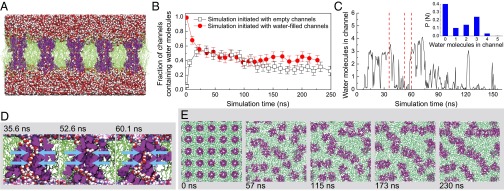Fig. 3.

MD simulations of PAP channels in a lipid environment reveal wetting–dewetting transitions of the pore and a tendency of the channels to aggregate. (A) A cutaway view of the simulated system. PAP channels are depicted in purple, the POPC bilayer is in green, and water molecules are shown as red and white van der Waals spheres. The image shows the system 1 ns after inserting water molecules into the channels. (B) The average fraction of channels that contain water molecules as a function of the simulation time. Irrespective of whether the simulations were initiated with empty or water-filled channels, the system equilibrated to ∼40% of the channels containing water. In this plot, 0 ns corresponds to the beginning of free equilibration. The error bars represent the error of the mean. (C) The number of water molecules present in a PAP channel during a representative fragment of an MD trajectory. Inset shows the normalized probability of observing a given number of water molecules in a PAP channel. The probability was computed by examining the occupancy of all channels during the last 200 ns of two MD trajectories sampled every 0.1 ns. Red dashed lines indicate the time points of the snapshots shown in D. (D) Wetting/dewetting of a PAP channel. The channel is shown as purple van der Waals spheres, POPC lipids are shown in green stick representation, and water molecules are shown by red and white van der Waals spheres. The cyan arrows indicate the region of the channel that was used to determine the occupancy and permeability of the channels. (E) A sequence of snapshots illustrating the aggregation of PAP channels in the lipid bilayer. Each image shows a top view of the simulation system. PAP channels are depicted in purple, POPC lipids are shown in green stick representation, and water is not shown. When released from constraints, channels migrate through the membrane and form clusters. For the simulations initiated with water-filled channels, the average cluster sizes with SD were as follows: 0 ns, 1.0 ± 0.0; 57 ns, 1.9 ± 1.4; 115 ns, 3 ± 3; 173 ns, 8 ± 6; and 230 ns, 13 ± 13. Simulations initiated with empty channels showed similar clustering behavior.
